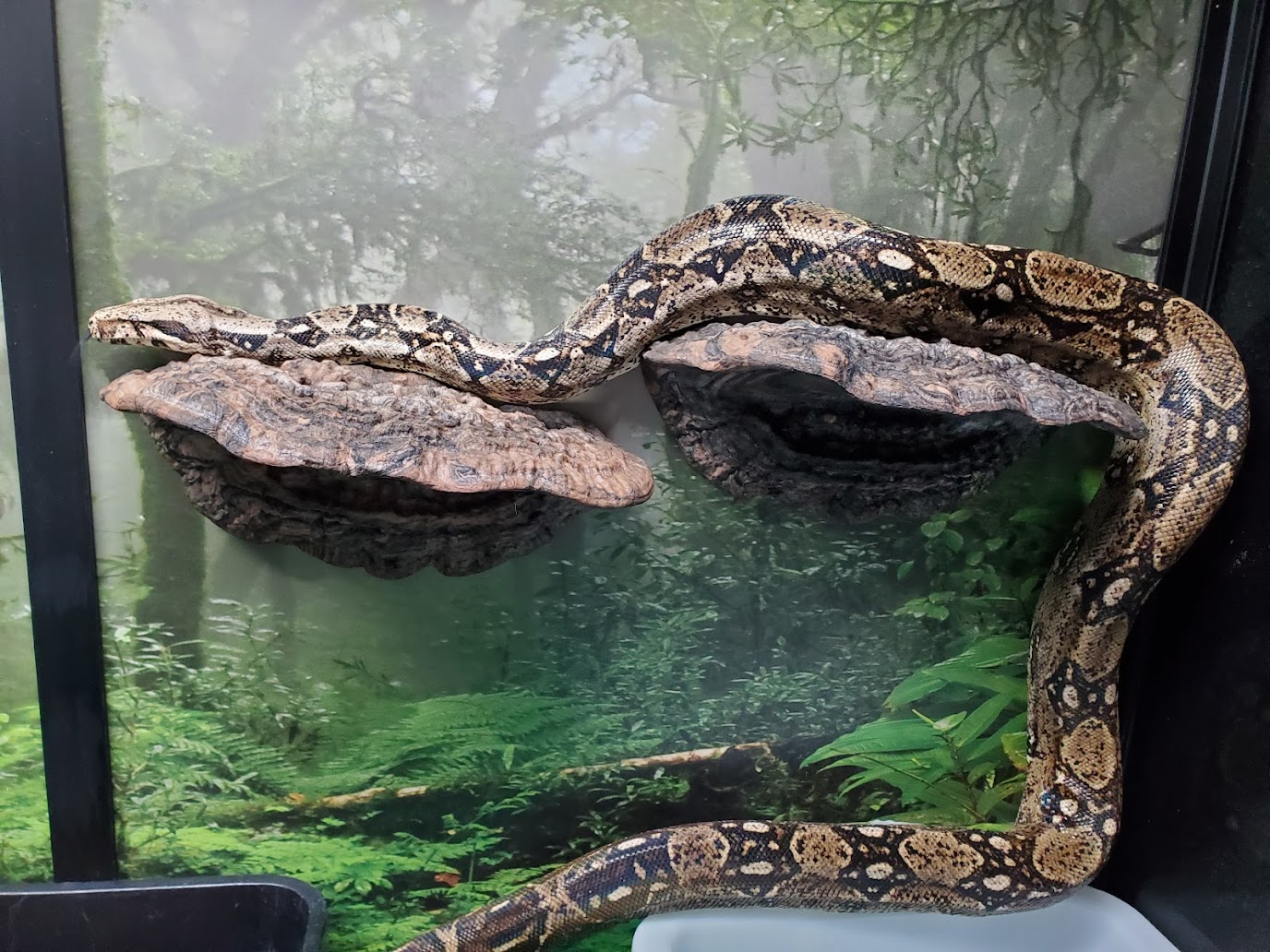BioTrek Animals
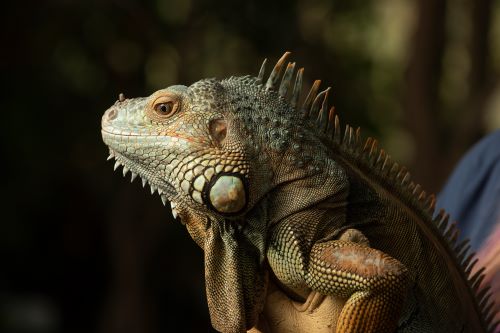
Galileo - Green Iguana (Iguana iguana)
Scientific name: Iguana iguana
Other common names: Iguana, American Iguana, Common Iguana, Common Green Iguana
Habitat:
The Green Iguana is native to the rainforests of northern Mexico, Central America, the Caribbean Islands, and southern Brazil. However, it has also been introduced to various other locations, including Puerto Rico, Texas, Florida, Hawaii, and the U.S. Virgin Islands. These lizards are primarily arboreal, spending most of their time in the rainforest canopies and near bodies of water. Adults tend to live in higher areas of canopies, while juveniles live in lower areas.
Characteristics:
While they are called Green Iguanas, their coloration can vary significantly. Adults tend to have a more uniform color, while juveniles often exhibit a blotchy or banded pattern of green and brown. An individual's color can also change depending on temperature, health, or social status. Males generally display more vibrant colors than females.
Green Iguanas possess several distinctive physical features. Their strong jawbones are aligned with sharp, leaf-shaped teeth along the inner side. A dorsal crest of spines run from the neck to the tail, which is especially noticeable when they become frightened or are defending their territory. They have a dewlap under the throat, which is more pronounced in males. Their long, tapering tail serves as a versatile tool for balance, defense, and even swimming.
Behavior:
Green Iguanas are highly adapted to their arboreal lifestyle. They are skilled climbers, using their sharp claws and powerful limbs to navigate the rainforest canopy. Their excellent vision, including the ability to see ultraviolet wavelengths, aids in foraging, basking, and predator detection. Individuals will descend for moving between trees, swimming through water, escaping predators, mating, or laying eggs. In colder seasons, many will descend to the ground in order to bask under the sun. Basking sites often are the most common reason for territorial disputes among Green Iguanas.
Social behavior in Green Iguanas is most notable during the breeding season. Males exhibit territorial displays, including head bobbing, dewlap extension, and color changes, to attract females and establish dominance. Females can store sperm for several years, allowing eggs to be fertilized for later.
Diet:
These lizards are primarily herbivorous with age, with a diet consisting of leaves, flowers, and fruits. This diet is a crucial role in seed dispersal throughout their habitat. In addition, adults will occasionally consume bird eggs and large grasshoppers. Juvenile Green Iguanas will often consume insects and small animals to meet their higher protein requirements for growth.
Interesting facts:
- Green Iguanas possess remarkable abilities, including underwater breath-holding for up to 30 minutes, and agile climbing with a fall safety net of 50 feet.
- Green Iguanas have excellent vision with unique eye adaptations. They are able to spot shapes and motion at great distances. The “double cone” cells in their eyes allows for sharp color vision and ultraviolet wavelength detection. Green Iguanas also have a “third eye”, also known as the parietal eye. It is a photosensory organ on top of their heads. Although unable to form images, it aids in predator detection by sensing changes in light and movement.
- Juvenile Green Iguanas exhibit social behavior by forming familial groups during their first year, with males displaying protective instincts towards females.
Rendova (Ren) - Solomon Island Skink (Corucia zebrata)
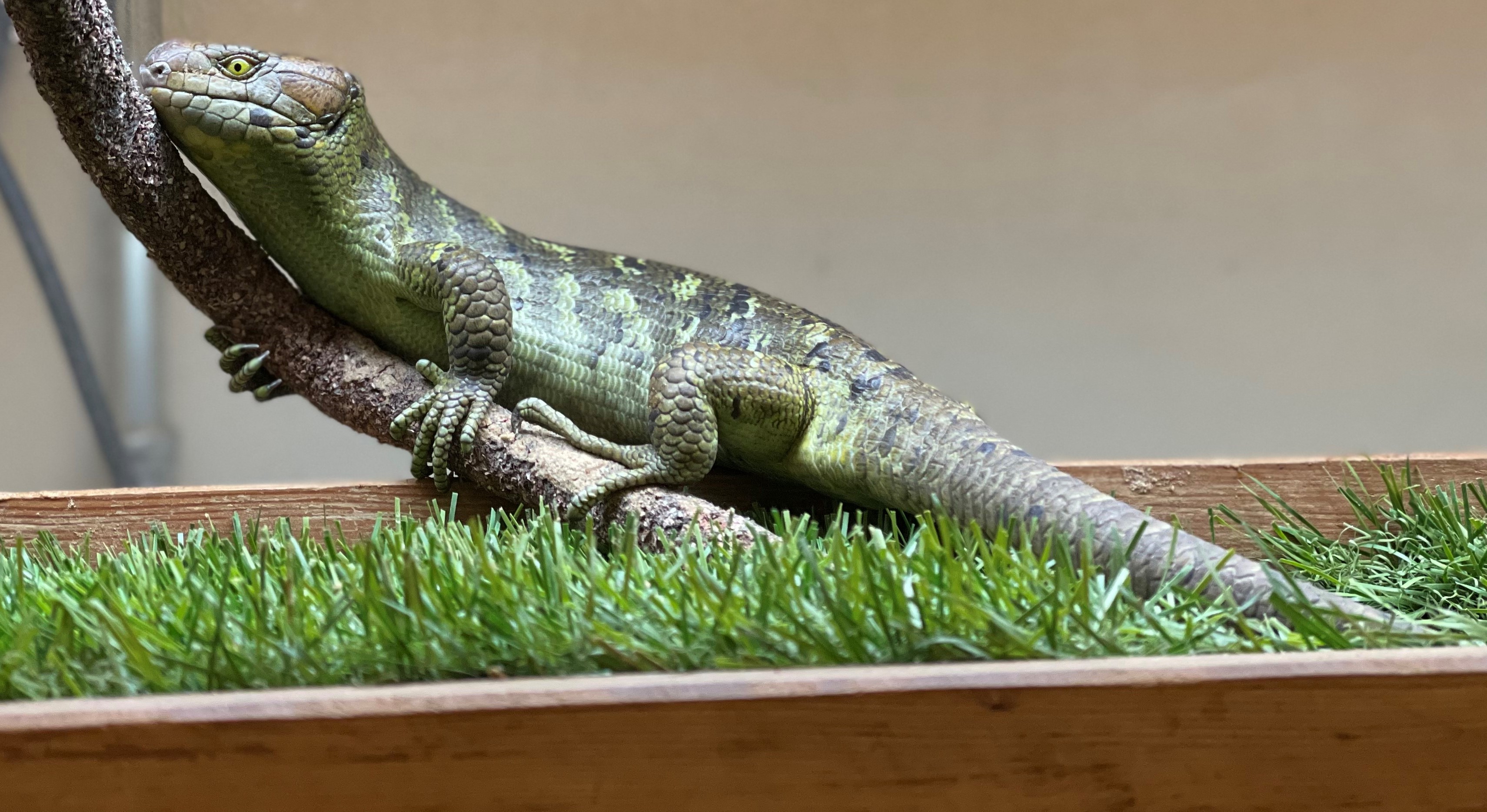
Scientific name: Corucia zebrata
Other common names: Monkey-tailed skink and Prehensile-tailed skink
Habitat
The Solomon Islands skinks are native to the Solomon Islands in the southwest Pacific Ocean and live in the upper canopy of forested areas throughout its range.
Characteristics
Adults can reach up to 32 inches in length from the nose to the tip of the tail. The tail can make up more than half its length. This prehensile tail is an adaptation to arboreal living, using it to grasp and maintain its balance on branches. Male skinks have a broader head with a more slender body than females. Males also have a “V” shaped scale pattern close to their cloacal opening, while females do not exhibit this pattern.
The dorsal scales are green with speckled green and black, and the ventral scales vary from light yellow to different shades of green. Their toes have curved nails to facilitate climbing up and down tree trunks and branches.
Behavior
The Solomon Islands skinks are crepuscular(active during dawn and dusk hours). They depend on their good vision to identify potential threats and food.
Although rare in most reptiles, the Solomon Islands skink is highly social by forming social groups known as a circulus. They live in these small family groups, working together to protect their territory and their young. Both males and females are aggressively territorial with unfamiliar individuals outside their circulus. They rely on their sense of smell to identify their own territory and members of their family group.
Diet
In the wild and captivity, they are strictly herbivores, eating a variety of leaves, fruits, and vegetables. They particularly eat the mildly toxic Solomon Island creeper plant also known commonly as the Pothos plant.
Interesting facts
- World’s largest species of extant skinks.
- Only known skink species with a prehensile tail
- Only known skink species to be strictly herbivorous
- They are viviparous (give birth to live young)
Jacaré and Lara - Cuvier's Dwarf Caiman (Paleosuchus palpebrosus)
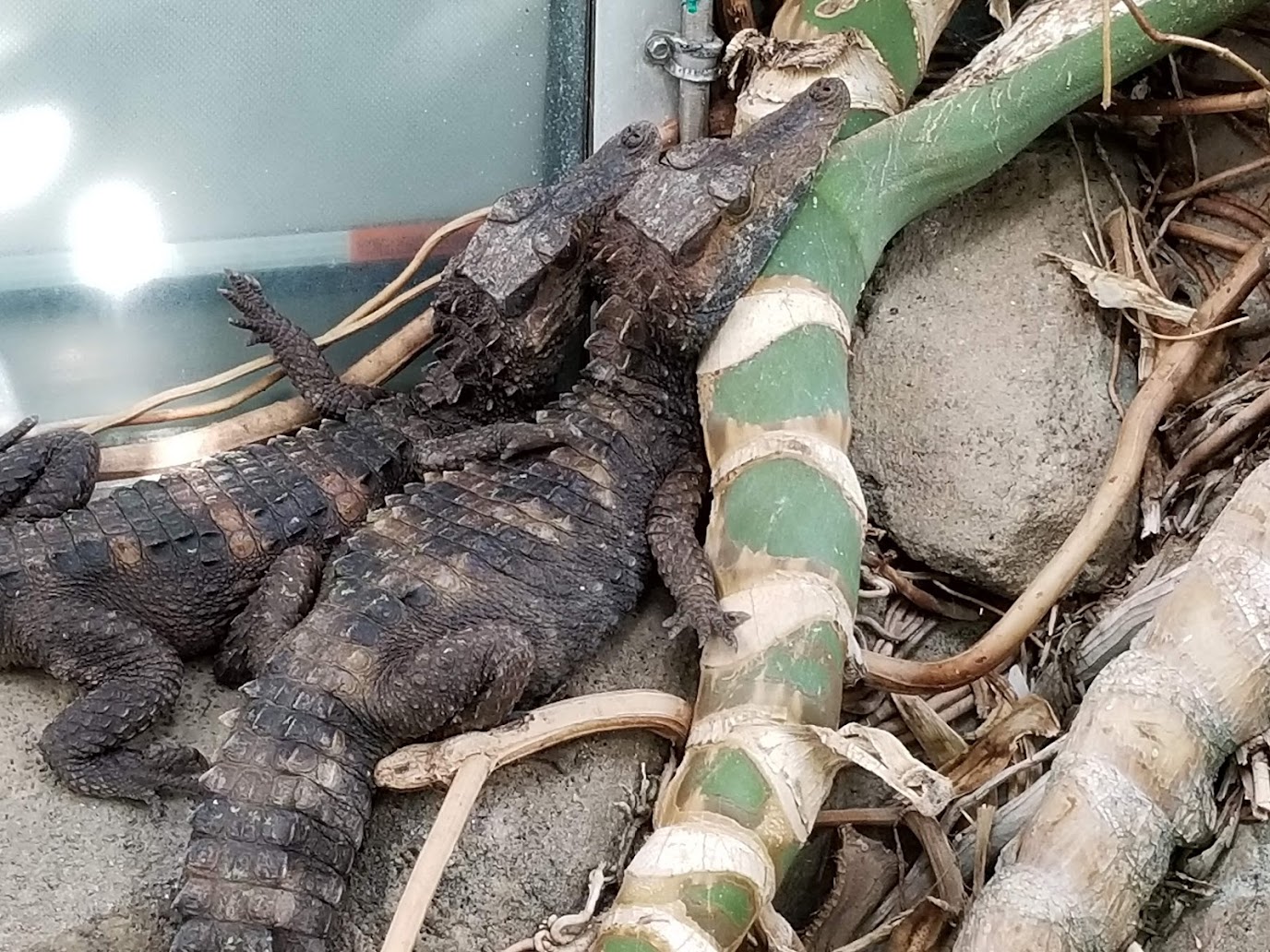
Scientific name: Paleosuchus palpebrosus
Habitat:
The Cuvier’s dwarf caiman is native to northern and central South America. They prefer fast moving streams or rivers around forested areas that contain waterfalls and rapids. In the wild, you will find them near cooler water areas such as rivers and inundated savannas such as the Orinoco and Amazon rivers in South America. If they are not in the water, you will most likely see them residing on rocks or branches near the water.
Characteristics:
The male caiman can grow up to 5.2ft and females grow up to 3ft 11in and can weigh between 13-15 lbs. They have a dark brown and black coloration with varying dark and light spots along its body while the tail is marked with encircling bands to the tip. They have strong body armor on both its ventral and dorsal sides, this includes the dermal scales with a bony base which are known as osteoderms, providing protection against potential predators. Their head is shaped differently than other crocodilians, with a dome-shaped skull and a short, smooth, concave snout with an upturned tip.
Behavior:
This species is nocturnal, during the day they like to spend their time basking on piles of rocks/branches or by staying afloat in water. At night they hunt their prey in the water or on land. The Cuvier dwarf caiman is a social species that either spends their time alone or in pairs as we see with Jacaré and Lara. They have interesting social behaviors to communicate with each other, they use sounds, movements, postures, smells, and touch. When in these pairs they can migrate long distances due to competition. Dominant males are very territorial and will exclude other males from resources such as mates, nesting sites and foraging areas.
They are keystone species, meaning that their survival greatly affects the healthy balance of organisms in their ecosystem. This caiman species helps keep the piranha population in check, without their presence the piranha population will dominate and drastically transform the ecosystem. The dwarf caiman eggs also play a vital role in becoming prey for other organisms.
Diet:
The Cuvier’s dwarf caiman is a carnivorous species that feeds on fish, amphibians, small mammals, birds, crabs, shrimp, mollusks, and other invertebrates. Juveniles mostly feed on tadpoles, frogs, and snails, and land invertebrates. Prey is swallowed whole and then grounded up in the digestive system, specifically in the gizzard.
Interesting facts:
- Only crocodilian species to not perform the “death roll” when feeding or in combat
- When threatened, caimans inflate their body to seem bigger and may also hiss aggressively
Scientific name: Boa constrictor
Other common names: Red-tailed boa and Common boa
Habitat:
Boa constrictors are native to the tropics of Central and South America. You will primarily find these snakes around humid areas, such as rivers and streams in a rainforest but they can also be found around semi-deserts, woodlands, dry tropical forests, and savannas.
Characteristics:
Boa constrictors are non-venomous snakes. They can reach up to 13 feet as adults and can weigh more than 100 pounds. Their color varies depending on the habitat they occupy to camouflage. Their base color can be tan, green, red, and yellow and their pattern can be cryptic (bars, lines, diamonds, or circles) with brown or reddish-brown coloration. This coloring becomes more pronounced at the tail which gives them their other common name, “red-tailed boa”. They have an arrow-shaped head with distinctive stripes that run dorsally from the snout to the back of the head, one that runs from the snout to the eyes, and then one from the eyes to the jaw.
Boa constrictors possess pelvic spurs, like other members of the family Boidae. Pelvic spurs are hind legs remnants found on the sides of the cloacal opening, larger in males, to help grip the female during courtship.
Behavior:
They are both terrestrial and semi-arboreal. Although they are excellent swimmers, they prefer to stay on dry land, using logs or abandoned animal burrows to stay hidden from potential predators.
Similar to most reptiles, they are solitary animals until it's time to find a mate. As nocturnal animals, they hunt at night and you will catch them basking during the day. Although tame in captivity, boa constrictors will hiss and strike at any perceived threat in the wild. Unlike other members of the Boidae family, boa constrictors lack heat-sensitive pits around their mouth, and instead, they are similar to most snakes that highly rely on their tongue and vision to collect sensory information.
Diet:
In their natural habitat, boa constrictors prey on small mammals and birds. To capture their prey, they use ambush hunting, this means that they sit and wait for a pretty item to pass by and when it does they rapidly strike to catch it.
Interesting facts:
- In the wild, they can live between 20-30 years, in captivity they can live between 25- 40 years.
- In captivity, their diet consists of rats and chicks.
- They help with rodent control in the wild.
- Viviparous (give birth to live young)
- Newborn boa constrictors are independent within minutes of birth
King George - Veiled Chameleon (Chamaeleo calyptratus)
Scientific name: Chamaeleo calyptratus
Other common names: Cone-Headed Chameleon, Yemen Chameleon
Habitat:
Veiled Chameleons are native to Yemen and Saudi Arabia, specifically favoring the deep valleys known as wadis in the Hijaz Mountains. They are well-adapted to their arid environment, with a preference for montane subtropical to tropical vegetation.These regions are characterized by deep valleys known as wadis, which provide the necessary vegetation and water sources. The chameleons are well adapted to the two distinct seasons in this region: the rainy season, which brings lush vegetation and abundant prey, and the dry season, which poses greater challenges for survival due to lower temperatures and scarce water. Furthermore, their range is expanded to California, Hawaii, and Florida due to human introduction. These small isolated groups of veiled chameleons do not change significantly in distribution mainly due to their slow movements and low population numbers.
Characteristics:
The Veiled Chameleon derives its name from the casque, a bony protrusion on top of its head. Resembling a veil or helmet, this structure channels water droplets into the chameleon's mouth; this is an adaptation for dry, mountainous habitats. Both male and female veiled chameleons possess this feature, though it is more pronounced in males. Adult females exhibit a green base with white, orange, yellow, or tan patches, while adult males display brighter coloration, more defined bands of yellow or blue, and some patches. Hatchlings emerge a pastel green, and gradually develop more vibrant colors and distinct markings as they mature.
Behavior:
Veiled Chameleons are diurnal and solitary. Courtship involves intricate color changes and posturing, with males displaying vibrant colors and engaging in head-bobbing and cautious approaches towards females. Males exhibit shades of green, yellow, blue, and brown to attract mates and establish dominance. Females, while less colorful, also undergo color changes, especially when gravid. After mating, females lay clutches of eggs, which are buried and hatch after six months.
Diet:
The Veiled Chameleon is primarily an insectivore, with a preference for certain prey types such as green insects. Notably, it is one of the few chameleon species that supplements its diet with plant matter, having adapted to consuming leaves as a water source during dry seasons.
Interesting facts:
- The Veiled Chameleon is the most common chameleon species in the pet trade, and have been bred in captivity for several decades. Their hardiness in captivity can be attributed towards being well-adapted towards a variable range in environmental conditions.
- Herpetologist (reptile and amphibian scientist) Petr Necas was one of the first to study the Veiled Chameleon in nature and noticed the individuals in many different habitats. He established the captive husbandry guidelines for this species and bred tens of thousands of them. As a result of selective breeding, he was responsible for the introduction of different color morphs to hobbyists worldwide.
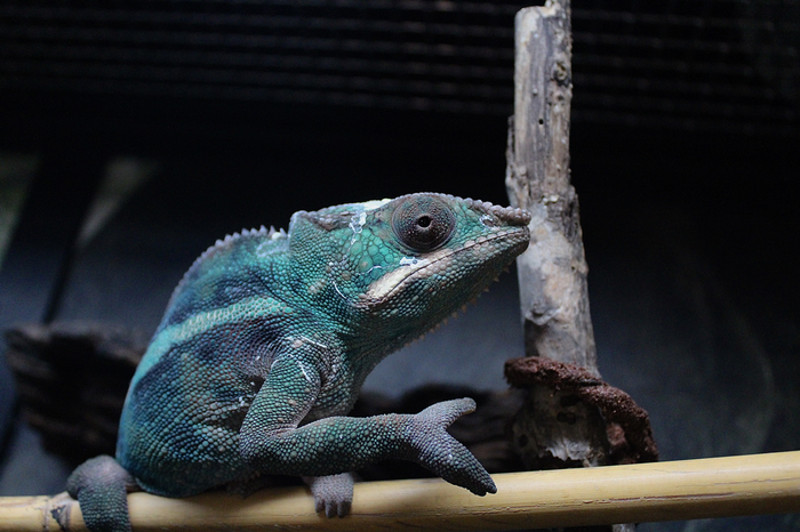
Pascal - Panther Chameleon (Furcifer pardalis)
Scientific name: Furcifer pardalis
Other common names: Jungle Chameleon, Tanala
Habitat:
The Panther Chameleon is native to the northern and northeastern regions of Madagascar and its neighboring islands, with introduced populations thriving in Réunion and Mauritius. This demonstrates their adaptability to a variety of habitats, including humid lowland coastal forests, rainforest canopies, scrublands, secondary vegetation, plantations, and gardens. However, they exhibit a preference for warm, dry deciduous forests near narrow strips of trees bordering roads or rivers. This preference for open, less shaded habitats is likely due to the need for basking sites and for males to employ visual signals for courtship and territorial defense. Studies of captive Panther Chameleons have revealed that males maintain larger home ranges than females, with females often remaining within a small area to receive visits from roaming males during the breeding season.
Characteristics:
Panther Chameleons exhibit remarkable color variation. Their base color can range from grey and turquoise to red, orange, pink, yellow, and green, largely depending on their geographical location, or "locale." Sexual dimorphism is evident in both size and coloration. Males are larger and more vibrantly colored, with distinctive features like a shovel-like rostral projection on the nose and prominent dorsal and gular crests. Males also typically have a white dorsolateral stripe and five vertical bands of darker color that extend as rings on their legs and tail. In contrast, females generally exhibit a more subdued color palette, primarily tan and brown with hints of pink, peach, or orange. Females also possess a less conspicuous dorsolateral stripe, often pinkish, cream, or orange.
Behavior:
Panther Chameleons are predominantly territorial, spending most of their lives in isolation except during the mating season. Males intensify their colors during social interactions like territorial disputes or courtship, with vibrant hues signaling dominance or attracting mates. Females, though less colorful, also use color changes to communicate receptivity or gravidity. They intensify their coloration when non-receptive to males, becoming darker with increased contrast against orange accents. When carrying eggs, females turn dark brown or black with orange striping to signal their unavailability for mating.
Diet:
Panther Chameleons are insectivores that primarily consume insects. However, their diet can occasionally include small birds and reptiles. While they are predators, they also fall prey to birds and snakes.
Interesting facts:
- The Malagasy people of Madagascar hold superstitions regarding chameleons, believing them to possess magical powers. Referred to as "Tanala," they are generally avoided and customarily pointed at with a knuckle rather than an outstretched finger, which is believed to require a subsequent blowing on the finger to negate any ill effects.
- Panther Chameleon colors vary depending on where they live in Madagascar. These color variations are called "locales" and are named after the nearest town or island such as: Nosy Be, Ambilobe, and Ambanja. For female panther chameleons, it is harder to identify their locale based on appearance alone as they are much less colorful.
- Breeding Panther Chameleons involves careful record-keeping to maintain the purity of locales and prevent accidental mixing of different color variations.
- The way Panther Chameleons are classified is a bit complex. While they are all considered one species, there's scientific debate about whether they should be divided into subspecies based on genetic and physical differences.
